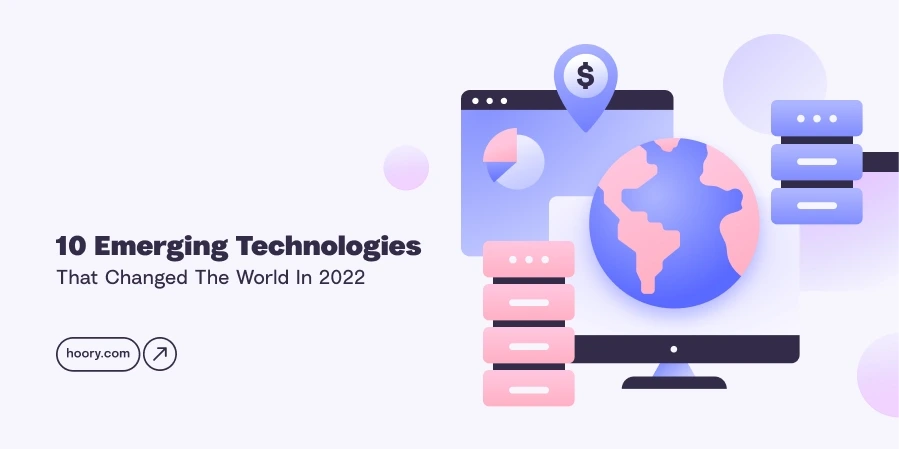10 Emerging Technologies That Changed The World In 2022
• Customer Support
• FastBank

The last twenty years have seen a massive evolution of emerging technologies, from the earliest stages of Web 2.0 to the beginnings of the metaverse in 2022. Among the highlights of 2022 technology were breakthroughs that earned spots on many top 10 emerging technologies 2022 lists, marking the year as a turning point in digital innovation. As we've come to expect, technology in 2022 continued to enrich our lives, and this momentum shows no signs of slowing as new technology 2022 trends pave the way for the future.
Regardless of our background in business or as consumers, the question we all come to ask is: what happens next?
What are Emerging Technologies?
In a basic sense, the term "emerging technologies" acknowledges how developments in tech often occur in the blink of an eye. The upheaval of what we associate as the "norm" (how we use the internet, what devices we interact with daily, etc.) happens more often than we realize. In the past, for example, we've become accustomed to voice-activated cloud services like Alexa and have familiarized ourselves with video chat software like Zoom.
As we reflect on technology in 2022, it's clear that change hasn't slowed down. In fact, many new technology 2022 trends have already started reshaping industries - from AI to biotech and beyond. Some of these emerging technologies may be familiar to you; some may exist in your periphery. Some, you might realize, are new or unfamiliar to you.
An important note, however, is that not all emerging technology is "new" in the strictest sense of the word. In many cases, "emerging" simply means that existing technology has become prominent through modern developments and innovations, leading to new uses and expanded relevance in the 2022 technology landscapes.
Let's take a look at the top 10 emerging technologies 2022 has brought to the forefront - innovations that are actively transforming our world.
Top 10 Emerging Technologies in 2022
1. Augmented and Virtual Reality
When discussing technology in 2022, augmented reality (AR) and virtual reality (VR) stand out as some of the most anticipated and talked-about developments. Virtual reality is an obvious choice among new technology 2022 trends - offering immersive, simulated digital landscapes accessible through wearable hardware like VR headsets and motion controllers.
Augmented reality, while similar, enhances the physical world by overlaying digital visuals onto real-world environments. Once seen as far-off science fiction, both AR and VR have now secured their place among the top 10 emerging technologies 2022 has to offer. As more leading tech companies invest in these platforms, the pace of innovation is accelerating, making AR and VR central to the 2022 technology conversation.
2. Natural Language Processing
Natural language processing involves the interpretation and manipulation of human language through artificial intelligence. In other words, this technology can convert written language into programming language, and vice versa.
For practical purposes, such as providing AI customer support, NLP involves two significant components. First: the understanding or comprehension of written inquiries from a human person. Second: the generation of language in order to give a response. Together, these components combine to create natural language processing.
AI-powered customer assistants like Hoory use natural language processing to improve communication and customer satisfaction.
3. Serverless Computing
Serverless computing, often referred to as FaaS (“function as a service”), is the newest iteration of cloud-computing technology for the modern age. In layman’s terms, “serverless computing” is described as a practice or model that allows developers to implement code into an application. What makes it “serverless” is that these developers do not need to manage a server or pay for cloud-based architecture to house their tests.
In addition to less hassle, developers and designers who use serverless computing typically save on costs. Rather than relying on a monthly cloud-based subscription, for example, they only pay for the time and frequency of code execution.
4. The Metaverse
If you were trying to describe the metaverse to your grandmother (or any other technologically-uninformed person), the most simple explanation you can give is this: it’s like the internet, if you made it three-dimensional. This doesn’t fully cover what the metaverse is about, but it’s a fair start.
Metaverse technologies have actually been around since as early as 1995, thanks to video games and other online platforms. But it’s with Meta (previously Facebook) that this platform is back in the public eye. More aptly described, the metaverse is a graphically rich virtual space.
It’s not that different from virtual reality, which uses headsets and motion controls to immerse the user. The key distinction, however, is that metaverse technologies are establishing shared community spaces rather than individual, linear game experiences. Users tapped into the metaverse can surf the web, browse online stores, or conduct meetings.
5. Blockchain Technology
The blockchain, in so few words, is often described as "digital ledger technology," keeping records of data and monetary transactions. As one of the top 10 emerging technologies in 2022, blockchain is revolutionizing how we secure and track information. For public blockchains to function, they operate via cryptocurrency, which is a decentralized virtual currency that isn't regulated by a central authority.
Because of its decentralized nature, blockchain technology in 2022 is virtually impossible to modify or hack by outsiders. Many consider blockchain's potential to extend far past the constraints of cryptocurrency for this very reason. Data and asset protection is a big concern for a wide variety of businesses, organizations, and other groups. Securing data on the blockchain appears to be the best way to maintain those assets, making it a standout new technology in 2022.
6. Web 3.0
The evolution of the internet is not something that happens overnight. Our collective, societal approach to improving web technologies is a slow and tentative transition over many years. This is in contrast to many other fields of technological development that occur at a rapid pace.
Our best example of this is the evolution of the internet’s earliest iteration (Web1.0) to what we are familiar with in the modern age (Web2.0). It was a matter of priority: while Web1.0 focused on data transfer and information access, 2.0 prioritized social and community-based interaction.
Of course, there is no singular purpose for developing the internet into a new age - an abundance of logistical and societal revisions make it complicated. This is why technological (and philosophical!) changes on the World Wide Web take time, because no singular entity is constructing the next iteration.
But as we know it, Web3.0, the next generation of the internet, seeks to decentralize this platform from massive corporations and instead place it in the hands of individual users. This is to be done through the innovation of blockchain technology - by decentralizing website databases, Web3.0 trends remove various authorities or governances from maintaining control.
7. 3D Printing
3D printing, when we first heard of it in the last five years, may have come across an interesting, if gimmicky, technological advancement. But it’s proven itself to hold massive potential for a diverse set of industries. Among them, the world has produced 3D-printed houses, prosthetics, musical instruments, human organs, and even 3D-printed steaks.
When this technology was first introduced, developers could only speculate on its hidden potential, and it’s only in the last year that 3D printing has exceeded that potential in great strides. There’s no telling what practical developments might occur with this technology in the future.
8. Autonomous Robotics
The industrialization of robots, historically, is no new concept in today’s day and age - we have seen robotics seamlessly implemented into manufacturing and production for decades. But what makes robotics relevant in 2022 is a large pivot towards making these technologies autonomous.
In other words, these are semi-intelligent robots that are capable of performing tasks and various operations independent from human guidance. Further, autonomous mobile robots (also known as AMR) are predicted to overtake 75% of the buying market of robots by 2030. The full potential for this form of technology has yet to be uncovered.
9. Wi-Fi 6
Wi-Fi (also stylized as wifi) has experienced some pretty radical improvements since its inception in the nineties. Initially coined by a nonprofit called Wi-Fi Alliance, this same group has since categorized each iteration of wi-fi technology throughout its lifespan. While Wi-Fi 6 was released in 2019, it’s only now (after years of use) that we can truly observe and review its wealth of benefits.
Among the perks this new generation of wi-fi includes, users experience faster navigation, a higher ceiling for gigabyte-per-second throughput, and a severe cut in latency.
10. AI Assistants
Most people are familiar with the concept of AI technology in a basic sense. Many of us, in fact, interact with it in our daily lives, even if we’re not fully aware of it. As we define it, “AI” is an umbrella term for various technologies capable of performing tasks that traditionally required human intelligence.
The most common forms of AI you might recognize are interactive voice recognition programs and automated chatbots. For businesses like Hoory, you’ll see a more sophisticated, conversational AI within its customer support package, capable of replicating natural human speech patterns.
Wrapping Up
The world around us is developing a mile a minute, and emerging technologies are quickly changing how we interact with the world around us. The way we develop new products, the way we engage with customers, and the way we interact with the internet are all positively evolving into the new age. It’s up to us as businesses and as consumers to pay attention to emerging technologies trends.

























